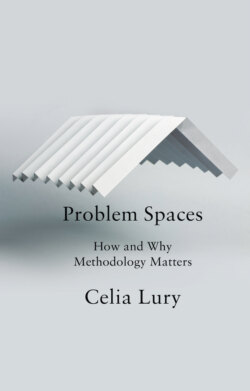Читать книгу Problem Spaces - Celia Lury - Страница 21
The methodological potential of the situation
ОглавлениеThese two approaches are as different to each other as the first two, but they are paired here to indicate some resources to further develop the understanding of problem space as a space of methodological potential. As indicated in the Introduction, conventional understandings of problem space deploy a concept of space as a container for a problem, setting limits that act to fix an inside and an outside, what the right or wrong context or environment for a problem might be, sometimes even implying that context or situation can be rendered inconsequential (‘context independence’). The two approaches described here offer instead ways to think about the co-emergence of a problem and a problem space in terms of a dynamic practice of situating. Haraway describes situatedness of knowledge not in terms of a fixed position or standpoint but, rather, as position-ing in webs of connection created in a process of splitting. In the practice of splitting, she says, there is a possibility of novelty and continuity in knowing. Figures are a symbolic condensation of that potential. Jullien says that ‘Potential is circumstantial’ (2004: 22) and suggests that, if we were to follow the way of the dao, ‘instead of setting up a goal for our actions, we could allow ourselves to be carried along by the propensity of things’ (2004: 16). Both thus describe the situation – situating or situatedness – as creating conditions for something like methodological potential, although they have different understandings of what that might mean.
The differences are of course revealing. Jullien uses potential and propensity more-or-less interchangeably, although the two terms are typically distinguished (in diverse ways) in Western philosophy. This interchangeability is related, it seems, to the ways in which Chinese cosmology allows for structure and change, statics and dynamics to be thought at the same time. ‘Translators’, Jullien observes ‘translate [shi] indifferently as “positions” or as “movements”. It is, however, precisely both at the same time’ (2004: 105). In calligraphy, he says, shi is the position of the brush, and the stroke, the movement of the brush. That much contemporary Western philosophy and social theory is concerned with the difficulties of how change and continuity may be thought at the same time – with relations between the possible and the real, the virtual and the actual, with whether, how and under what circumstances potential may be actualized, how potential is different from propensity and how both are to be distinguished from capacity – is, I suggest, a sign of both shared concerns in these approaches and continuing differences between Western and Chinese thought.10
